I principianti ci chiedono spesso di spostare i loro siti web su SSL o HTTPS. I termini possono sembrare troppo tecnici, ma in realtà è molto facile da fare.
L’HTTPS nell’URL di un sito web significa che questo utilizza un protocollo di trasferimento dati sicuro grazie all’installazione di un certificato SSL. Questo è importante perché la maggior parte dei browser moderni mostra avvisi per i siti web che non utilizzano HTTPS.
Fortunatamente, la maggior parte delle società di hosting affidabili e WordPress rendono molto facile proteggere il vostro sito web.
In questo articolo vi mostreremo come spostare il vostro WordPress da HTTP a HTTPS aggiungendo un certificato SSL. Non preoccupatevi se non sapete cosa sia SSL o HTTPS. Vi spiegheremo anche questo.
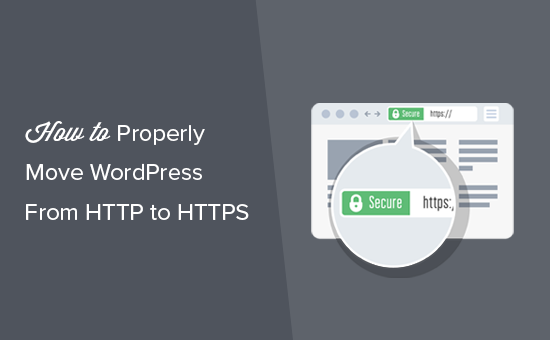
Ecco una rapida panoramica degli argomenti che tratteremo in questo articolo:
- What Is HTTPS?
- Why Do You Need HTTPS and SSL?
- Requirements for Using HTTPS/SSL on a WordPress Site
- Setting Up WordPress to Use SSL and HTTPS
- Method 1: Setup SSL/HTTPS in WordPress Using a Plugin
- Method 2: Set Up SSL/HTTPS in WordPress Manually
- Submit Your HTTPS Site to Google Search Console
- Bonus Resources
- Video Tutorial
Che cos’è l’HTTPS?
HTTPS, o Secure HTTP, è un metodo di crittografia che protegge la connessione tra il browser dell’utente e il vostro server. Questa maggiore sicurezza rende molto più difficile per gli hacker intercettare i dati trasferiti.
Ogni giorno le persone condividono i propri dati personali con i siti web, sia che stiano effettuando acquisti sia che stiano semplicemente effettuando il login. Abbiamo visto in prima persona quanto sia cruciale proteggere questo tipo di scambio di dati.
Per garantire la sicurezza dei dati, è necessario stabilire una connessione sicura.
È qui che entrano in gioco SSL e HTTPS.
Ogni sito web riceve un certificato SSL unico per l’identificazione. Se un server tenta di utilizzare HTTPS senza un certificato valido o se il certificato non corrisponde, la maggior parte dei browser moderni avvisa gli utenti e consiglia loro di non procedere.
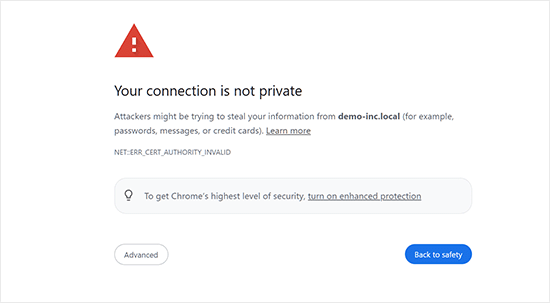
Ora, potreste chiedervi perché sia necessario spostare il vostro sito WordPress da HTTP a HTTPS, soprattutto se si tratta di un semplice blog o di un sito web di una piccola azienda che non effettua pagamenti.
Perché avete bisogno di HTTPS e SSL?
Nel 2018 Google ha annunciato un’iniziativa per aumentare la sicurezza del web, esortando i proprietari di siti a passare da HTTP a HTTPS. Per supportare questa mossa, il browser Chrome ha iniziato a contrassegnare tutti i siti web senza un certificato SSL come “Non sicuro”.
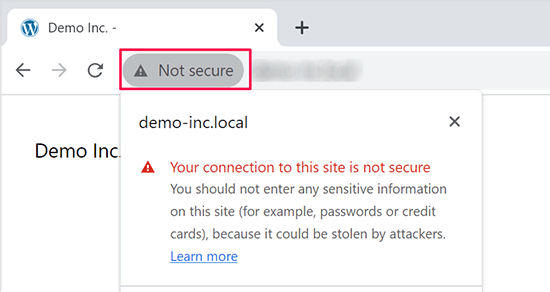
Google ha anche detto che i siti con SSL avrebbero ricevuto vantaggi SEO e avrebbero potuto ottenere un posizionamento di ricerca più alto rispetto ai siti non sicuri. Questo annuncio ha spinto molti proprietari di siti a passare all’HTTPS.
Una volta diffuso l’avviso “Non sicuro”, Chrome ha iniziato a segnalare i siti HTTP. Ad esempio, visitando un sito HTTP in modalità incognito o compilando un modulo di contatto su un sito HTTP si attiva l’avviso, contrassegnandolo come non sicuro.
Quando i visitatori vedono questo avviso, possono lasciare un’impressione negativa del vostro sito o della vostra azienda.
Per questo motivo tutti i siti web devono passare all’HTTPS e installare l’SSL il prima possibile.
Inoltre, l’SSL è indispensabile se si desidera accettare pagamenti online sul proprio sito di e-commerce.
I fornitori di pagamenti come Stripe, PayPal Pro e Authorize.net richiedono una connessione di pagamento sicura.
Ci assicuriamo che i nostri siti utilizzino l’SSL, compresi WPBeginner, OptinMonster, WPForms e MonsterInsights.
Requisiti per l’utilizzo di HTTPS/SSL su un sito WordPress
I requisiti per l’utilizzo di SSL in WordPress non sono molto elevati. Tutto quello che dovete fare è acquistare un certificato SSL, che potreste già avere gratuitamente.
Le migliori società di hosting WordPress offrono certificati SSL gratuiti a tutti i loro utenti:
Per maggiori dettagli, consultate la nostra guida su come ottenere un certificato SSL gratuito per il vostro sito WordPress.
Se il vostro ospitato non offre un certificato SSL gratuito, dovrete acquistarne uno.
Raccomandiamo Domain.com perché offre la migliore offerta di certificati SSL normali e wildcard.
Acquistando un certificato SSL, si ottiene anche un sigillo TrustLogo per il proprio sito web. Ogni certificato SSL viene fornito con una garanzia di sicurezza minima di 10.000 dollari. I prezzi partono da 33 dollari all’anno e i certificati SSL vengono rinnovati automaticamente.
Una volta acquistato un certificato SSL, dovrete chiedere al vostro provider di hosting di installarlo per voi.
Avete bisogno di aiuto per impostare l’SSL e passare all’HTTPS?
Se non avete tempo per impostare l’SSL, il nostro servizio diassistenza Premium WordPress è qui per aiutarvi! Possiamo gestire l’intero processo per voi, assicurandovi che il vostro sito sia sicuro e pronto per i visitatori.
- Tassa una tantum
- Tempi di consegna rapidi
- Disponibile su richiesta 24 ore su 24, 7 giorni su 7
Potete stare tranquilli sapendo che il vostro sito è in mani esperte. Contattateci oggi stesso per un’installazione SSL e una migrazione HTTPS senza problemi!
Impostazione di WordPress per l’utilizzo di SSL e HTTPS
Dopo aver abilitato un certificato SSL per il vostro dominio, dovrete impostare WordPress per utilizzare i protocolli SSL e HTTP sul vostro sito web.
Vi mostreremo due metodi per farlo e potrete scegliere quello più adatto alle vostre esigenze.
Metodo 1: Impostare SSL/HTTPS in WordPress utilizzando un plugin
Questo metodo è più semplice ed è consigliato ai principianti.
Per prima cosa, è necessario installare e attivare il plugin Really Simple SSL. Per maggiori dettagli, consultate la nostra guida passo passo su come installare un plugin di WordPress.
Dopo l’attivazione, è necessario visitare la pagina Impostazioni ” SSL. Il plugin rileverà automaticamente il vostro certificato SSL e imposterà il vostro sito WordPress per l’utilizzo di HTTPS.
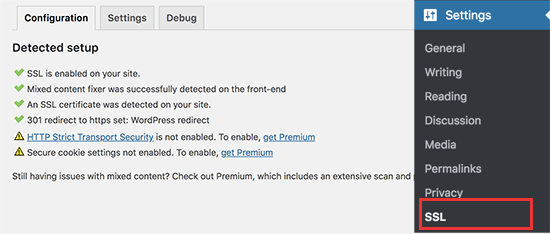
Il plugin si occuperà di tutto, compresi gli errori di contenuto misto. Ecco cosa fa il plugin dietro le quinte:
- Controllare il certificato SSL
- Impostate WordPress per utilizzare https negli URL
- Impostazione di reindirizzamenti da HTTP a HTTPS
- Cercate nei vostri contenuti gli URL che vengono ancora caricati da fonti HTTP non sicure e cercate di risolverli.
Nota: il plugin tenta di risolvere gli errori di contenuto misto utilizzando una tecnica di buffering dell’output. Questo può avere un impatto negativo sulle prestazioni, perché sostituisce il contenuto del sito mentre la pagina viene caricata. Questo impatto è visibile solo al primo caricamento della pagina e dovrebbe essere minimo se si utilizza un plugin per la cache.
Anche se il plugin dice che è possibile mantenere SSL e disattivare il plugin in modo sicuro, non è vero al 100%. Dovrete lasciare il plugin sempre attivo perché la disattivazione del plugin riporterà gli errori di contenuto misto. Per maggiori dettagli, consultate la nostra recensione di Really Simple SSL.
Metodo 2: Impostazione manuale di SSL/HTTPS in WordPress
Questo metodo richiede la risoluzione manuale dei problemi e la modifica dei file di WordPress. Tuttavia, è una soluzione permanente e più ottimizzata dal punto di vista delle prestazioni e la stiamo utilizzando su WPBeginner.
Se trovate questo metodo difficile, dovreste assumere uno sviluppatore WordPress o utilizzare il primo metodo.
Potrebbe essere necessario modificare il tema di WordPress e i file di codice come parte di questo metodo. Se non l’avete mai fatto prima, consultate la nostra guida su come copiare e incollare frammenti di codice in WordPress.
Per prima cosa, è necessario visitare la pagina Impostazioni ” Generale. Da qui, è necessario aggiornare i campi dell’indirizzo URL di WordPress e del sito sostituendo http con https.
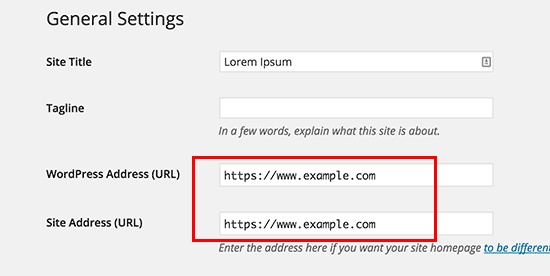
Non dimenticate di fare clic sul pulsante “Salva modifiche” per memorizzare le impostazioni.
Una volta salvate le impostazioni, WordPress vi farà uscire e vi chiederà di effettuare nuovamente il login.
Successivamente, è necessario impostare il reindirizzamento di WordPress da HTTP a HTTPS aggiungendo il seguente codice al file .htaccess:
1 2 3 4 5 | <IfModule mod_rewrite.c>RewriteEngine OnRewriteCond %{HTTPS} offRewriteRule ^(.*)$ https://%{HTTP_HOST}%{REQUEST_URI} [L,R=301]</IfModule> |
Se si utilizzano server NGINX, è necessario aggiungere il seguente codice per reindirizzare da HTTP a HTTPS nel file di configurazione:
1 2 3 4 5 | server {listen 80;server_name example.com www.example.com;return 301 https://example.com$request_uri;} |
Non dimenticate di sostituire example.com con il vostro nome di dominio.
Seguendo questi passaggi, eviterete l’errore WordPress HTTPS not working perché WordPress ora caricherà l’intero sito web utilizzando HTTPS.
Se si desidera forzare SSL e HTTPS nell’area di amministrazione di WordPress o nelle pagine di login, è necessario configurare SSL nel file wp-config.php.
Aggiungete il seguente codice sopra la riga “That’s all, stop editing!” nel file wp-config.php:
1 | define('FORCE_SSL_ADMIN', true); |
Questa riga consente a WordPress di forzare SSL/ HTTP nell’area di amministrazione di WordPress. Funziona anche sulle reti multisito di WordPress.
Una volta eseguita questa operazione, il sito web è completamente configurato per l’utilizzo di SSL/ HTTPS, ma si verificheranno ancora errori di contenuto misto.
Questi errori sono causati da fonti (immagini, script o fogli di stile) che vengono caricate utilizzando il protocollo HTTP non sicuro negli URL. In questo caso, non è possibile vedere l’icona del lucchetto sicuro nella barra degli indirizzi del sito web.
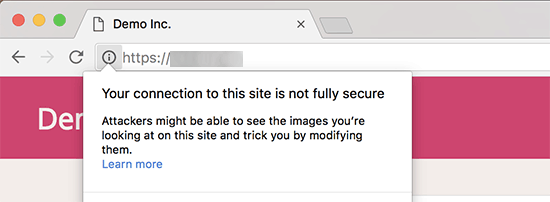
Molti browser moderni bloccano automaticamente gli script e le risorse non sicure.
Potreste vedere un’icona a forma di lucchetto, ma con una notificazione su chi siamo, nella barra degli indirizzi del browser.
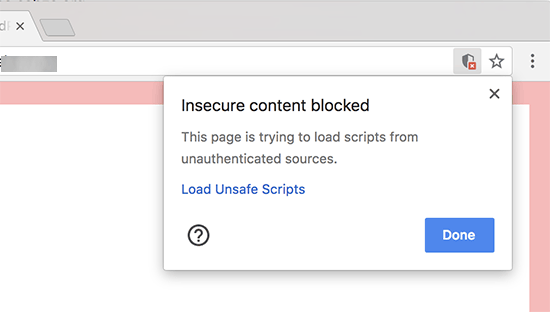
È possibile scoprire quali contenuti sono serviti attraverso un protocollo non sicuro utilizzando lo strumento Inspect.
L’errore di contenuto misto viene visualizzato come un’attenzione nella console con dettagli per ogni elemento di contenuto misto.
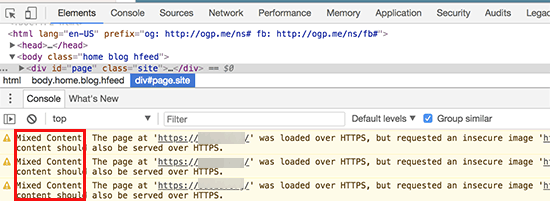
Si noterà che la maggior parte degli URL sono immagini, iframe e gallerie di immagini, mentre alcuni sono script e fogli di stile caricati dai plugin e dai temi di WordPress.
Correggere il contenuto misto nel database di WordPress
La maggior parte degli URL errati sono immagini, file, embed e altri dati memorizzati nel database di WordPress. Per prima cosa correggiamoli.
La cosa migliore sarebbe trovare nel database tutte le menzioni del vecchio URL del sito web che iniziano con HTTP e sostituirle con il nuovo URL del sito web che inizia con HTTPS.
È possibile farlo facilmente installando e attivando il plugin Search & Replace Everything. Per maggiori dettagli, consultate la nostra guida passo-passo su come installare un plugin di WordPress.
Dopo l’attivazione, è necessario visitare la pagina Strumenti ” WP Search & Replace. Nel campo “Cerca”, dovete aggiungere l’URL del vostro sito web con http. Successivamente, aggiungere l’URL del sito web con https nel campo “Sostituisci”.
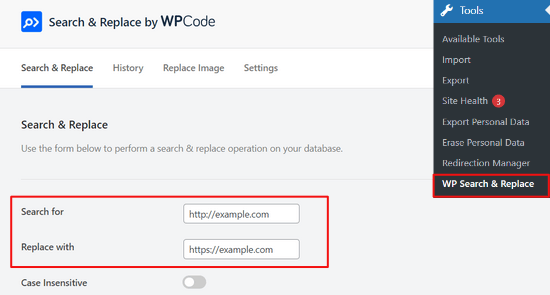
Di seguito, vengono visualizzate tutte le tabelle del database di WordPress.
È necessario selezionarli tutti per eseguire una verifica approfondita.
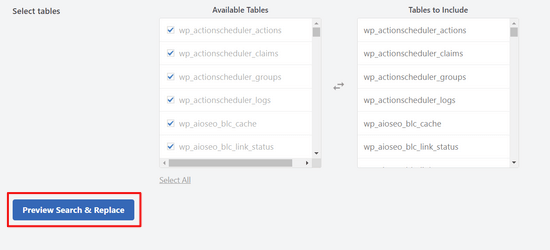
Quindi, fare clic sul pulsante “Anteprima di ricerca e sostituzione” per vedere tutte le modifiche apportate dal plugin.
Infine, fare clic sul pulsante “Sostituisci tutto”.
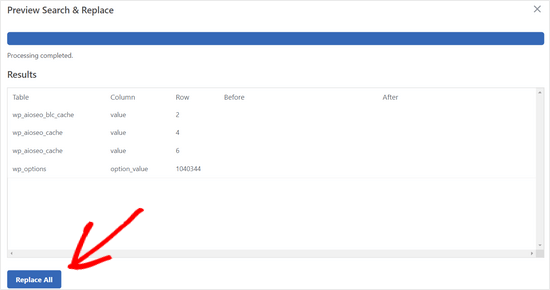
Il plugin cercherà ora nel database di WordPress gli URL che iniziano con http e li sostituirà con URL sicuri https. Potrebbe essere necessario un po’ di tempo, a seconda delle dimensioni del database di WordPress.
Correzione degli errori di contenuto misto nel tema WordPress
Un’altra causa comune degli errori di contenuto misto è il tema di WordPress. Qualsiasi tema WordPress decente che rispetti gli standard di codifica di WordPress non causerà questo problema.
Per prima cosa, è necessario utilizzare lo strumento di ispezione del browser per trovare le risorse e la loro provenienza.
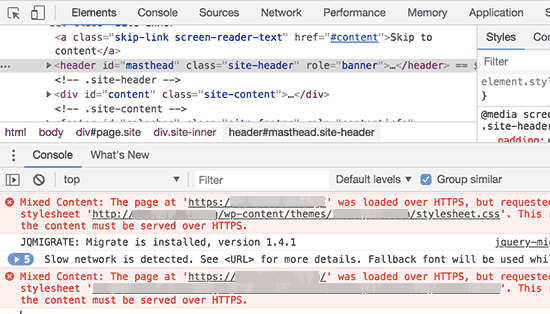
Successivamente, dovrete trovarli nel vostro tema WordPress e sostituirli con https. Questa operazione sarà un po’ difficile per la maggior parte dei principianti, poiché non sarà possibile vedere quali file del tema contengono questi URL.
Correzione degli errori di contenuto misto causati dai plugin
Alcune risorse a contenuto misto vengono caricate dai plugin di WordPress. Qualsiasi plugin di WordPress che rispetti gli standard di codifica di WordPress non causerà errori di contenuto misto.
Non consigliamo di modificare i file dei plugin di WordPress. Dovreste invece contattare l’autore del plugin e farglielo sapere. Se non rispondono o non sono in grado di correggere il problema, è necessario trovare un’alternativa adeguata.
Nota: se per qualche motivo si verifica ancora un errore di contenuto misto, si consiglia di utilizzare temporaneamente il plugin Really Simple SSL, in modo che gli utenti non ne risentano mentre si corregge il problema su un sito web di staging o si assume uno sviluppatore.
Inviate il vostro sito HTTPS a Google Search Console
I motori di ricerca come Google considerano https e http come due siti web diversi. Per evitare problemi di SEO, è necessario comunicare a Google che il sito web è stato spostato.
Per farlo, è sufficiente accedere all’account di Google Search Console e fare clic sul pulsante “Aggiungi proprietà”.
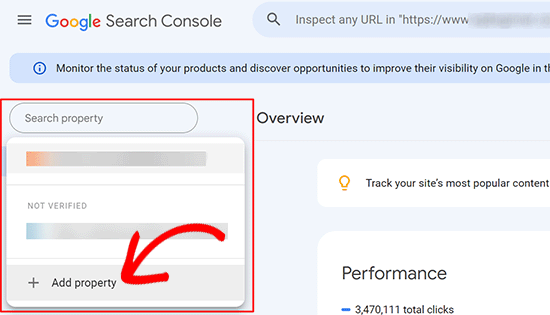
Si aprirà una finestra a comparsa in cui dovrete aggiungere il nuovo indirizzo https del vostro sito web.
Esistono due metodi per la verifica del sito: il nome di dominio o il prefisso URL. Consigliamo il metodo del prefisso URL perché è più flessibile.
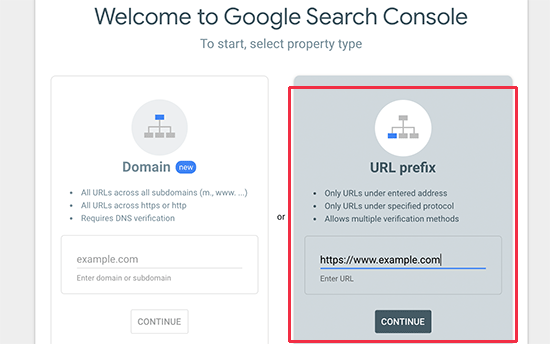
Successivamente, Google vi chiederà di verificare la proprietà del vostro sito web.
Ci sono diversi modi per farlo. Selezionate un metodo qualsiasi e riceverete le istruzioni per verificare il vostro sito. Si consiglia di utilizzare il metodo dei tag HTML.
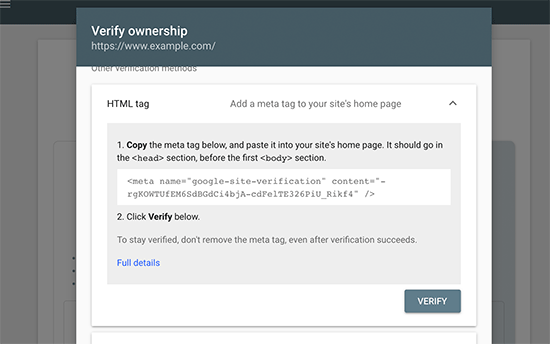
Ora vedrete uno snippet di codice HTML da aggiungere alla sezione head del vostro sito web WordPress.
Aggiungere il codice di verifica di Search Console utilizzando All in One SEO
Innanzitutto, installate e attivate il plugin All in One SEO for WordPress. Per maggiori dettagli, consultate il nostro tutorial su come installare un plugin di WordPress.
Nota: esiste anche una versione gratuita di All in One SEO che potete provare.
Dopo l’attivazione, accedere alla pagina All in One SEO ” Impostazioni generali e fare clic su Google Search Console.
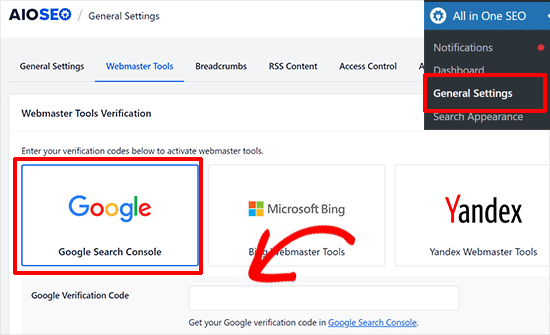
In seguito, è necessario aggiungere il codice di verifica copiato in precedenza dal sito web di Google Search Console.
Non dimenticate di cliccare sul pulsante “Salva modifiche” per memorizzare le impostazioni.
Quindi, tornare alla scheda Google Search Console e fare clic sul pulsante “Verifica”.
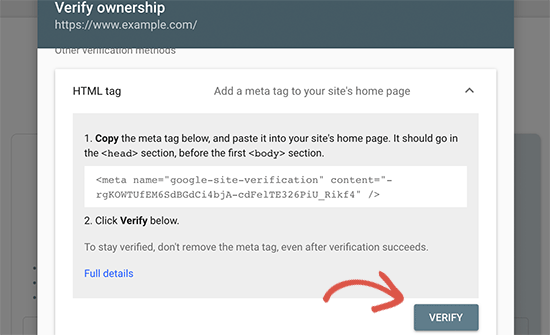
Una volta che il sito è stato verificato, Google mostrerà qui i rapporti della Search Console.
È inoltre necessario assicurarsi che entrambe le versioni https e http siano aggiunte alla Search Console.
Questo indica a Google che volete che la versione https del vostro sito web sia trattata come la versione principale. In combinazione con i reindirizzamenti 301 impostati in precedenza, Google trasferirà le classifiche di ricerca alla versione https del vostro sito web e molto probabilmente vedrete dei miglioramenti nelle vostre classifiche di ricerca.
Risorse bonus
Di seguito sono riportate alcune risorse aggiuntive che possono aiutarvi a risolvere da soli i problemi comuni di WordPress e a saperne di più su WordPress:
- Come correggere i problemi SSL più comuni in WordPress (Guida per principianti)
- Gli errori più comuni di WordPress e come risolverli
- TLS vs SSL: quale protocollo utilizzare per WordPress?
- Come correggere l’errore di connessione sicura in WordPress
Video tutorial
Speriamo che questo articolo vi abbia aiutato ad aggiungere HTTPS e SSL in WordPress. Potreste anche voler consultare la nostra guida definitiva alla sicurezza di WordPress con istruzioni passo-passo per mantenere sicuro il vostro sito WordPress o come rinnovare il vostro certificato SSL.
Se questo articolo vi è piaciuto, iscrivetevi al nostro canale YouTube per le esercitazioni video su WordPress. Potete trovarci anche su Twitter e Facebook.





Weslry
This article is a little bit trap for newbie because if you first change to https in your wp panel and then try to add those codelines to right files you can’t reach your webiste or wp admin panel. (443 error) I had to edit files through ftp and made myself fool at work for making such a mistake. So first you have to get the certificates and edit htaccess file etcetc and then add that S in your wp admin panel (or directly edit thorugh ftp).
Daryl
Thanks for heads up ! good article
Huseyn
Hi! Thank you for this article. Very useful!
But I was faced with one problem. After installing SSL (I use free version of Cloudflare SSL) I cannot edit any pages/posts/products. Does anybody face with such problem? And how did you solve it?
Thanks in advance!
Michael Penner
Thank you for the excellent and easy to understand article about WordPress and SSL. I was pleasantly surprised to see it was from one of my favorite plugin authors. Cheers!
WPBeginner Support
Hi Michael,
Glad you found it helpful
Admin
Maurizio Mau
Hi and many thanks for post,
i have implemented SSL, run good on all bowser included mobile, load in 1.5 sec, console upgraded, analitucs upgraded, redirect done, fixed all element but ranking drop approx 20% and above…
Onis Egwu
Hello There,
Wonderful article. The issue I have with using the .htaccess file to route through https is that whenever WordPress updates, it cleans off the edits done.
Is there a way to avoid this?
max
hi there,
i saw your post and is interesting..but i can’t understand one thing… I read you article and i made all about it … in admin area is ok all is https..
but the front end no .. i mean when i see the site with chrome the padlock appear and then disappear ???!??!?!
any ideas?
Hardy
I am having the same issue. :/
Swapan Kumar Manna
Hello,
I’ve purchased an SSL certificate form Godaddy and it is approved and downloaded the .crt file. I’m bit confused what are the next steps to install the file in the server and how to redirect all the URLs in the existing WordPress site. Can anyone give me the detailed guide step by step.
Also requesting WPBeginer to write an article on this topic “How to install SSL certificate in Godaddy.
Thanks.
Cathy Larkin
did you fix your issue? I am getting ready to do this. I thought GD did it for you?
Rohit
Hi, as you said I went to my wordpress blog settings page and changed my domain url to https from http and clicked save however Now I am not able to login to my wordpress dashboard and getting 404 error.
How can I solve this please becuase I cannot even login to my wordpress dashboard to change it back to http again
Abhay
Hello sir, I want to know why you are not using https on wpbeginner?
WPBeginner Support
Hi Abhay,
We don’t use HTTPS because we don’t collect any secure data. We do plan to change as our needs will change in the near future.
Admin
Pat B
Fantastically clear and helpful instructions. Many thanks!
Brody James
Hi,
This worked great after following your steps. However, I notice that a few pages i.e. contact page does not display the green SSL lock but still displays https://
How do I fix this?
Thanks
BJ
Vaggelis
That really rocked!!! Thank you so much. The https rocks


Esther
Thanks so much for this.
Amin
all SSL redirections have problems with cookies didn’t found a solution from a year now. can someone help ? plz ? there is a big problem on auth cookies .. and got redirect to reauth=1
there is no synch of cookies between front and backend , and authors get disconnected when they upload files .. I think it’s related to root/wp-load.php and /wp-admin/async-apload.php
Amritosh Pandey
Please try this –
# BEGIN WordPressRewriteEngine On
RewriteCond %{SERVER_PORT} !^443$
RewriteRule (.*) https://{HTTP_HOST}%{REQUEST_URI} [R=301,L]
RewriteBase /
RewriteRule ^index\.php$ - [L]
RewriteCond %{REQUEST_FILENAME} !-f
RewriteCond %{REQUEST_FILENAME} !-d
RewriteRule . /index.php [L]
# END WordPressJoe
This Worked for me in my .htaccess file, all I needed to do was to change the port to “80”
The htaccess snippet in the post just refused to work.
thanks for this.
Amy
Hi, just wanted to let you know I added Let’s Encrypt to my site and changed it in my WordPress dashboard it automagically updated the LOGIN page. I didn’t need to add the code to the wpconfig.php file.
I wonder if this is a new addition to WordPress?
Meenakshi
Hi,
I recently moved my WP site from WP’s free hosting to another hosting site, the issue I’m facing is with SSL. Any help from here is appreciated?
Daniel
What issues are you having?
sujith
Hi , after converting to https i am getting error like
“You do not have sufficient permissions to access this page” in wp-admin
Not able to access wp-admin.
When i revert the changes its working fine.
Can anybody please help
Bruce
My website is redirecting under
https to a different website and I cannot find where the redirect is.
Any ideas as to where to look would be appreciated.
I have tested the plugins by disabling them.
I have tested the themes by changing themes.
I have looked at the htaccess.
All works well except under https where it redirects to one of my other sites.
Any help appreciated.
Rrich
Hi,
I changed the wordpress and site address at the General settings tab at wordpress from http to https. And I can’t access my site again.
I now get your site is insecure when Ii type in he url.
I can’t even access the admin.
Please help
Karl D.
Don’t know if you got this fixed, but you can go into mysql (phpMyAdmin) and look for the table wp-options. There you will find a table entry titled “siteurl” and one titled “home” you can remove the s from https in the url there and your site will come back. I would make sure that you have the .htaccess and wp-config edited like stated in this article first and upload them to your site first and check if things work from there. If not, reset the .htaccess and wp-config file and edit the mysql like stated above and your site will come back when accessed without the https.
Good luck!
Best,
Karl D.
Kalle
Thanks Karl ! This worked ! I just edited the files in (phpMyAdmin) !
So if you mess with http / https settings with your wP try this !
I tried to edit my .httaccess file for 2-3 hours…..
Moty
After activation and change force admin ti https can’t login- Page Not found 401
can you please let me know how can I revert the changes?
thanks
Moty
I have erased the plugin via file manager,
Now can login to my wp admin but still can’t get into the plugins panel VIA Wp ,
it is asking for an https address
Please help
Thanks
Naeem Hussain
Dear Sir WPbeginner,
I installed SSL + dedicated IP Certificate to my Wp Website name computerpakistan.com. Now its everything working fine, But problem with my website page speed.
Before SSL Speed
1.8 seconds
After SSL Installation site page Speed
4.3 Secondes by gtmatrix report
Ritesh
I am not able to access the admin area after I uploaded define(‘FORCE_SSL_ADMIN’, true); to wp-config.php. My site was already using wordpress https plugin with force ssl administration checked in. I removed that plugin using ftp but I am still not able to login. It says incorrect username or password. However neither the password nor the username has been changed. I think this was the problem after I tried adding define(‘FORCE_SSL_ADMIN’, true); to wp-config.php. I can see the login page on https version of the site but not able to login. Please guide further.
Ritesh
Its absolutely blank page and nothing else.
The Platypus
I’m hopeful you ran a back up before doing any changes to your site.. in either case revert back your site to an earlier state via your database, and whatever back up of your config.php file you have.
Florin
I’m having the same problem. I checked everything but I still cannot login in my admin area.
Stephen
I had a similar problem after enabling FORCE_SSL_ADMIN in wp-config.php.
The login page etc. was coming up ok over HTTPS but it wouldn’t let me login successfully.
In this case, it was a plugin interfering – “Chap Secure Password Login”. After deactivating it, logins worked ok (and in fact, it’s not needed when WordPress is configured to force SSL on the admin page).
So I would suggest checking any login related plugins and try deactivating them.
Another issue is if you are using something like HAProxy in front of your webserver for load balancing, and get something like a “too many redirects” error message after trying to move WordPress to HTTPS.
In this case, you most likely need to modify wp-config.php to tell WordPress that the connection is actually HTTPS, otherwise it will keep trying to redirect even when the client connection is over HTTPS. There are some details here,
Monu
Hello sir I am using wordpress with https and www ……………….. in my site everthing is okay url of posts and pages are also use https but in google search results not show https in my website address only show http://www.example.com/post...
WPBeginner Support
You will need to inform Google about change of address from Google Webmaster Tools.
Admin
Raivat
Hi, I followed your tutorial. Thanks, Everything works! But I am getting an error when I load the home page saying “Your connection to this site is private, but someone on the network might be able to change the look of the page”. I checked it out and it seems there is a problem in one of my font resources which uses Google Fonts with http instead https, can you show me how can I fix this?
Thanks
Sebastian
Try removing the “http://” from the Google Font call. So it’s not being forced across HTTPS. The reference call to the Google Font link should start with the “www.” instead of “http://”
Naval Gupta
Should we use 301 redirect to redirect all http pages to https pages?
Mark Cohen
Everything working fine, except that when on Dashboard > Home I get exclamation mark across padlock in URL bar. Anyone know what content is being served insecurely on this page?
Joel
I made the changes in the site before I set up the certificate and now can not access the back end of my site.
David gillies
Hi followed your example and now cant access the website at all
if I try
all I get is jumbled page with no styling
WPBeginner Support
Instead of WordPress HTTPS SSL, please try Really Simple SSL plugin.
Admin
Adrienne
I need to do this soon for my nonprofit site, and I’m scared! Paying for this is going to be extra too, but I have to do it!. Thanks for this info….
Paying for this is going to be extra too, but I have to do it!. Thanks for this info….
Lourdes
So this comes up when I google my Blog Page. Using Bluehost/wordpress – DOES THIS MEAN O need to fix the SSL Cert issue aka buy from bluehost? Thank you!!!!
[We didn’t find any SSL certificate present on the website which is bad for users privacy. The site has a title but meta description is absent, it will be better for SEO if both are present. Homepage is in English.]
Maxim
Thanks for this post! Helped a lot!
Penny
What if you have Mixed Content going on and were asked to fix that before you proceed with installing SSL?
My Firewall, Sucuri said that I need to fix the mixed content before they can install the SSL. Now I’m stuck and do not know how to proceed. I’m nervous with installing plugins. They recommended really-simple-ssl plugin. Have you had any experience with this? I try to limit the using plugins…
Milon
Thanks BRO
Jarred
We installed the plugin WordPress HTTPS (SSL). We chose to only use SSL on specific pages option and everything is working great. However we have two important questions that came about after reading the GOOGLE article about migrating to https. Not sure if I can share link on here, so this is the title “Secure your site with HTTPS” on support google.
Questions.
1. Does the plugin WordPress HTTPS (SSL) automatically create 301 redirects to help search engines know we moved to https on those specific pages?
2. If the plugin does not create the 301 redirects, do WE need to go ahead and create the 301 redirects manually for those specific pages that we added SSL on? Thank you in advance
WPBeginner Support
See if the plugin is redirecting by checking it with an online redirect checker tool. If it isn’t, then you can setup your own redirects.
Admin
Jarred
I followed your advice and found a redirect tool. We used it and realized that the WordPress HTTPS (SSL) plugin DID in Fact create 301 redirects automatically. Great review and tutorial on this blog post and everything is working great. Thanks
WPBeginner Support
Glad you found it helpful
adam vikar
For a multisite setup, is there a code we can use to force SSL on the main site and NOT a specific subdomain?
Michelle
I put the wrong info in the SSL host box and now I get a 404 error. I cannot get back to any of my pages to disable the plugin or to change the info in the SSL host box. Please advise….
Easiest solution - delete the plug-in
The easiest solution is to delete the plug-in.
Access the files on your server (If you are using cPanel, you can use ‘File Manager’
Browse to where the plug-ins are kept
/wp-content/plugins
Find the plug-in and delete it.
Hiep Pro
You can use ftp client to delete plugin folder on web dir.
Jithin Johny George
Hi,
Awesome step-by-step guide.
But the plugin you have mentioned,WordPress HTTPS (SSL) has not updated in years.
Is there any alternative for the plugin ?
Thank You
Penny
I was advised by my firewall company to use Really Simple SSL. I haven’t tried it yet but they highly recommend it.
Kris Gabriel
Fantastic guide, simple and usefull.
The only thing to worry about is that the redirects causes the page to slow a bit down.
Is implementing the code listed above into the .access file the first choice or is it better with just a plugin?
I´ve chosen both options, that means both a wordpress https plugin AND .access code.
Would you say that is benicial or not?
Kind regards
Kris
Mursaleen Kamal
Assalam Alaikum Sir: We Have Been Successfully Implement this Guide on Our Website But We Still Facing Redirect issue,
Our Website Is Accessing from Both URL
http and https
and How to Resolve Mix Content Issue?
WPBeginner Support
Try really simple SSL plugin.
Admin
Ahmed Muhi
Thank you so much it worked.
Ali
Hello,
Thank you for your guide. I add this code in my htaccess file
RewriteEngine On
RewriteCond %{SERVER_PORT} 80
RewriteRule ^(.*)$ https://www.yoursite.com/$1 [R,L]
but now it do not do 301 redirect it is doing 302 redirect.
Please tell me is it ok to do 302 redirect or not.
Regards
WPBeginner Support
A 301 redirect means that the page has permanently moved to a new location. A 302 redirect means that the move is only temporary. Search engines need to figure out whether to keep the old page, or replace it with the one found at the new location.
Admin
Ana
Thanks for the article, but I should definitely have read it before adding the SSL and https to WP. Total newbie but somehow managing a wordpress site..
Changed WP site address on the settings page from http to https after an update recommendation on my admin panel. But now I can’t access the website or admin page! All I get is a blank page with the message ERR_TIMED_OUT and site can’t be reached.
I realised I hadn’t activated the free SSL certificate that comes with our web hoster. Now I have done that and I’ve tried adding a WP SSL redirect (http to https) code to the .htaccess file as well. And tried adding define force_SSL_admin to wp-config.php, but nothing has changed and I don’t know how to undo or fix the issue. Any suggestions or experience in this issue would be very helpful!
WPBeginner Support
Try using Really Simple SSL plugin.
Admin
mirko
sorry, but…I did not understand the part of .htaccess files … Must I add code to my htaccess or mix with my file ?
my original file is the default wordpress file
# BEGIN WordPressRewriteEngine OnRewriteBase /RewriteRule ^index\.php$ - [L]RewriteCond %{REQUEST_FILENAME} !-fRewriteCond %{REQUEST_FILENAME} !-dRewriteRule . /index.php [L]#ENDWordPress1-click Use in WordPress
The New file is correct ?
# BEGIN WordPressRewriteEngine OnRewriteCond %{SERVER_PORT} 80RewriteRule ^(.*)$ https://www.yoursite.com/$1 [R,L]RewriteEngine OnRewriteBase /RewriteRule ^index\.php$ - [L]RewriteCond %{REQUEST_FILENAME} !-fRewriteCond %{REQUEST_FILENAME} !-dRewriteRule . /index.php [L]#ENDWordPress1-click Use in WordPress
Thank you, Mirko
WPBeginner Support
The new file redirects your users to HTTPS
Admin
Jim
I’m a little unclear what needs to be in the htaccess file to force SSL
This is my current htacess
g
after changing the url in general settings, all css styles are gone, and the wp-login page to change this setting is not showing because of to many redirects. be aware before using this tut, I have to back up.
WPBeginner Support
Please see our guide on how to fix too many redirects error in WordPress.
Admin
Mark C
Hi, what about if we’re using it only for the login.php page, where do we configure it?
christopher
Thank you for your article! I was wondering though, my website recently has suffered some problems with “too many redirects” error. I wonder if adding the .htaccess code you mentioned in the article for ssl redirect will make the problem worse? Some visitors to my website said they often see “this page isn’t redirecting properly” when they come to our website. Could it be that our customers are having trouble visiting our website because I don’t have that code in my .htaccess file?
Melvin
Hi! I was wondering if there’s a reason why you only want SSL on specific pages instead of the whole website? Could this be because of performance?
Ahmed
Hello Syed! Great tutorial. I just want to ask that when ssl error window appears in browsers. Whether its the time to login,shopping or everytime you visit specific websit….For example if I have a blog which don’t offer login or shopping whteher ssl certificate is required or not???
WPBeginner Support
It is not required, but will certainly give you plus points in search results.
Admin
Jaclyn Mamuzich
Hello,
For some reason our blog is not showing as https even though we have an ssl installed and I thought it was done before the migration but I could be wrong. I followed the steps in the article (greatly appreciated but for some reason when I complete all the steps, almost all of my styling disappears, specifically related to layout. Any suggestions?
but for some reason when I complete all the steps, almost all of my styling disappears, specifically related to layout. Any suggestions?
thanks!
Rob
As with JACLYN MAMUZICH. I have followed all the steps and when the site is viewed in https:// all the CSS has gone. Any suggestions?